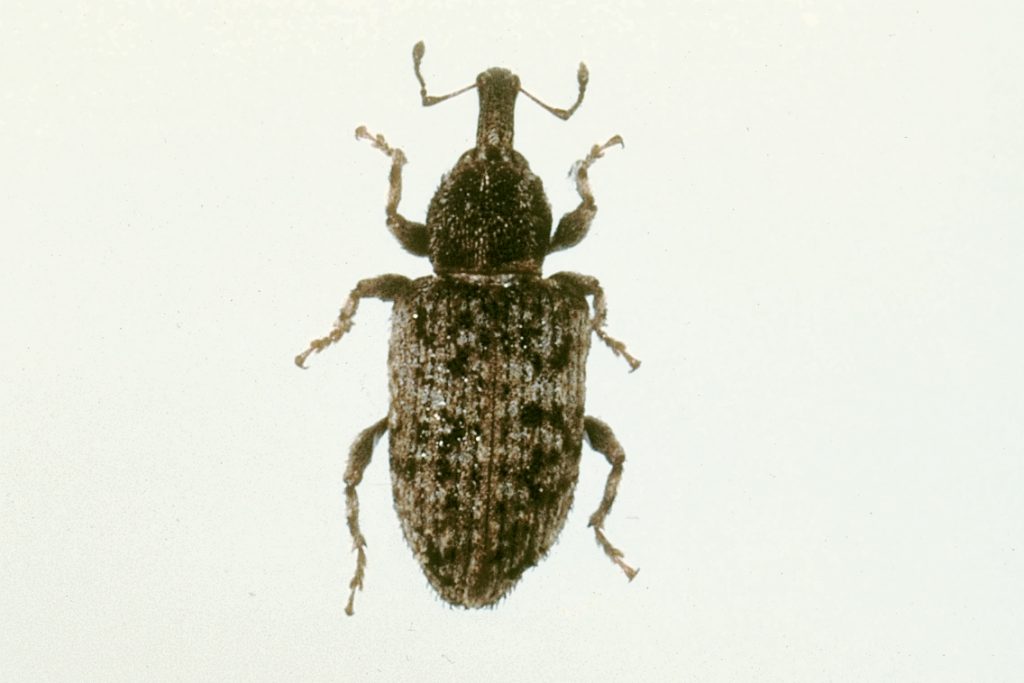Spotted vegetable weevil
Steriphus diversipes
Other common names
Desiantha weevil

Photo by Western Australian Agriculture Authority, 2015
Summary Top
Also known as desiantha weevils, spotted vegetable weevils are medium sized weevils that attack cereals and canola in eastern and southern Australia. Adults are mottled grey-black in colour. Larvae are white legless grubs with a brown head and spend their life underground. Crop rotations away from grass-based pastures will reduce populations, and seed treatments will reduce larval damage to cereals.
Occurrence Top
The spotted vegetable weevil is a sporadic pest that is native to Australia and widely distributed. They are present in Queensland, New South Wales, Victoria, Tasmania, South Australia and Western Australia.
Description Top
Adults are mottled grey-black weevils with grey flecks on the abdomen and the typical elongated weevil snout. They grow up to 7 mm long and are flightless. Larvae are white, legless grubs with orange-brown heads and grow to 8 mm in length. This species was previously Desiantha maculata.


Lifecycle Top
Adults lay eggs in soil that hatch in autumn after opening rains. In spring larvae pupate and adults emerge during spring through to early summer. They have one generation per year.

Behaviour Top
As larvae are legless, they are restricted in their movements. Spotted vegetable weevil larvae are confined to living underground. They feed on germinating cereal or grass seed or the stem of emerging plants. Adults chew on cotyledons, leaves and stems and are most active at night.
Similar to Top
Spinetailed weevil
Crops attacked Top
Cereals and canola. Capeweed and grassy weeds are also favourable hosts.
Paddocks that were in pasture with abundant capeweed the previous season are at highest risk.
Damage Top
Larvae attack cereals at the seedling and tillering stages. They feed underground on germinating seeds, and bore into the stems of seedlings and tillers, often killing plants or resulting in abnormal and stunted growth. In contrast, canola is mostly damaged by adults. They chew cotyledons, leaves and stems of canola plants and may eat small plants down to ground level.
This weevil can damage successive crops.
Monitor Top
Crops that follow a long-term pasture are most likely to be at risk. Inspect newly sown paddocks and germinating seedling crops, looking for poor emergence or bare patches. In cereals, search for the presence of larvae by digging in the soil. Search an area of 30 cm x 30 cm square and to a depth of 10 cm. Repeat this 5 to 10 times across the paddock. In canola, monitor emerging crops for damage and weevils using direct visual searches. Searches may need to be undertaken during the night, as this is when spotted vegetable weevils are most active. Pitfall traps are also a very effective technique to assess the abundance of weevils. Inspect entire paddocks as spotted vegetable weevils are often distributed across the entire paddock.
Economic thresholds Top
There are no economic thresholds established for this pest.
Management options Top
Biological
There are no known predators, parasites or pathogens that effectively control spotted vegetable weevil.
Cultural
Avoid sowing susceptible crops into long-term pasture paddocks. Crop rotations that include only one year, or at most two years, of pasture between cereal crops will reduce pest occurrence. Control alternate hosts, including grass weeds, during late spring, summer and early autumn to reduce the survival rate of adults and minimise egg numbers.
Chemical
There are no foliar insecticides registered against the spotted vegetable weevil, however chlorpyrifos is registered as an insecticide seed dressing for cereals in some states. Seed treatments can reduce larval feeding damage to cereal seedlings but there may still be some plant death before the larvae are killed. There is evidence that suggests insecticides used against vegetable weevil may also provide control of spotted vegetable weevils (Micic et al 2008).
Acknowledgements Top
This article was compiled by Paul Umina (cesar) and Bill Kimber (SARDI).
References/Further Reading Top
Bailey PT. 2007. Pests of field crops and pastures: Identification and Control. CSIRO Publishing, Melbourne, Australia.
Grimm M and Michael P. 1989. Desiantha: a pest of germinating crops on the south coast. Farmnote 76. Department of Agriculture, Perth.
Henry K, Bellati J, Umina P and Wurst M. 2008. Crop Insects: the Ute Guide Southern Grain Belt Edition. Government of South Australia PIRSA and GRDC.
Micic S, Hoffmann AA, Strickland G, Weeks AR, Bellati J, Henry K, Nash MA and Umina P. 2008. Pests of germinating grain crops in southern Australia: an overview of their biology and management options. Australian Journal of Experimental Agriculture 48, 1560-1573.
| Date | Version | Author(s) | Reviewed by |
|---|---|---|---|
| February 2015 | 1.0 | Paul Umina (cesar) and Bill Kimber (SARDI) | Garry McDonald (cesar) |
What are PestNotes?
PestNotes are information sheets developed through a collaboration between Cesar Australia and the South Australian Research and Development Institute (SARDI). Copyright: © All material published in PestNotes is copyright protected by Cesar Australia and SARDI and may not be reproduced in any form without written permission from both agencies.
Disclaimer
The material provided in PestNotes is based on the best available information at the time of publishing. No person should act on the basis of the contents of this publication without first obtaining independent, professional advice. PestNotes may identify products by proprietary or trade names to help readers identify particular products. We do not endorse or recommend the products of any manufacturer referred to. Other products may perform as well as or better than those specifically referred to. Cesar Australia and PIRSA will not be liable for any loss, damage, cost or expense incurred or arising by reason of any person using or relying on the information in this publication. Any research with unregistered pesticides or products referred to in PestNotes does not constitute a recommendation for that particular use.

